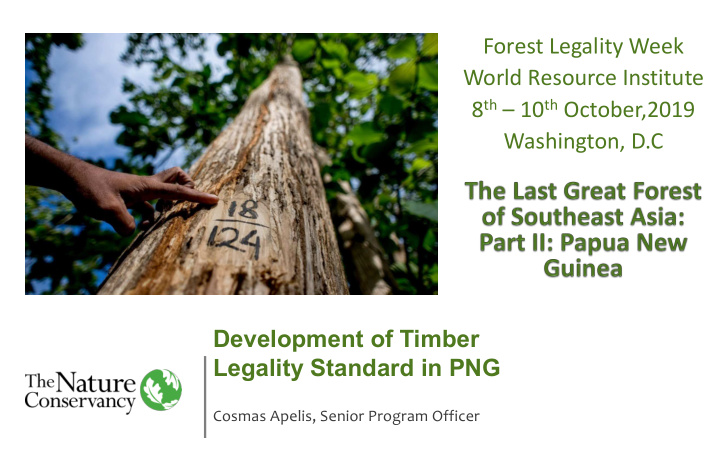



Forest Legality Week World Resource Institute 8 th – 10 th October,2019 Washington, D.C Development of Timber Legality Standard in PNG Cosmas Apelis, Senior Program Officer
Our mission is to conserve the lands and waters on which all life depends 4,000/ 600 employees/ 1M+ 50 scientists active members U.S. state chapters 120M acres of land 70+ protected countries 1,400 100 preserves managed Marine conservation 6,500 projects in 21 countries & river km all U.S. coastal states protected
PNG Country Program Vision: “Papua New Guineans sustainably manage their extraordinary cultural heritage and natural diversity upon which life depends”. Strategic Themes: 1. Ridges to Reef integrated planning 2. Sustainable forest management, and 3. Sustainable fisheries management
PNG Context Population: 7.6 Million Languages: 800 Islands: 600 Poverty: 40% live on <$USD2/day Rural: 90% Economy : Natural resources Biodiversity: 200,000 plus species
Sustainable Forest Management strategy • Under the Responsible Asia Forest (RAFT) Partnership, a multi-year initiative supported by the US and Australian Government, TNC in collaboration with EU/FAO supported PNGFA and stakeholders to further field test and refine the draft PNG Timber Legality Standard.
PNG Timber Legality Standard • The Papua New Guinea Timber Legality Standard (PNG TLS) provides an agreed definition of what constitutes legal timber sourced from PNG and Registered Forest Industry Participants (FIPs) compliance with the relevant legal frameworks as tested against this definition.
PNG TLS Development Timeline Year Action ITTO FAO/EU and TNC 2006 International workshop on EU-FLEG: workshop outcomes developed into a project proposal. 2007 Project approved by ITTO 2008-2009 Preparatory work on project implementation 2010- 2013 Project Implemented. A TLS developed with other outputs of the project (consisting of 2x documents-National and Local Standard- essentially Checklists) 2014 Testing of the PNG TLS- Stettin Bay Lumber Company (West New Britain Province) 2016 International stakeholder workshop on EU FLEGT and the PNG TLS presented 2017 April 2nd Testing Madang Timbers (Madang Province) 2017 June 3rd Testing Kamula Dosa (Western Province) 2017 Multi-stakeholder Technical Meeting Nov 2017 National Stakeholder workshop of the PNG TLS Mar 2018 Multi-stakeholder Technical Meeting May 2018 PNG NFB Submission for endorsement June 2018 Withdrawn from the NFB to due to issues raised by Civil Society Organizations (1 st Dialogue) and to develop the supporting Timber Legality Verification System (TLVS). 2 nd PNGFA-CSO Dialogue Nov 2018 3 rd PNGFA-CSO Dialogue June 2019
Summary of the TLS Structure Goal: PNG Forest Industry Participants are making an effective contribution towards legal and sustainable forest management Objective: PNG Forest Industry Participants are complying with all relevant social, environmental and economic laws & regulations. Principles: 1. Compliance with rights to harvest within forest areas that are legally acquired. 2. Compliance with requirements regarding forest management including compliance with relevant environmental, labour and community welfare laws. 3. Compliance with requirements concerning business operations, taxes, import & export duties, royalties and fees, directly relating to timber harvesting & trade. 4. Compliance concerning tenure rights or use rights to land & resources that may be affected by timber harvest rights, where such rights exist. 5. Compliance with requirements for processing, transport, trade and export procedures 6. Maintenance of the necessary registers. Criteria • Broad conditions that need to be complied with by PNG’s Forest Industry participant (FIP) • Each criterion helps demonstrate compliance with a particular Principle. Indicators • These are specific measurable conditions that needs to be complied with. • Potential sources of information or evidence that allows an auditor to evaluate compliance with a Criteria. Verifiers • Specific sources of information or objective evidence that allows an auditor to evaluate compliance with an Indicator. • The list is not exhaustive, and an assessor may use other means of verification.
• The document structure (consolidation of all Refinements/Improvements requirements into a single document); to the draft TLS • Mechanisms (inclusion of Verifiers for each Indicator); • Broaden the scope with inclusion of PNGFA procedures; • Focus (from a narrow scope to a specific FIPs and operations); • Fact checking and review. • Appropriately, the draft PNG TLS makes extensive ‘use’ of existing PNGFA Procedures, but the current legal requirements to be a FIP will restrict many small-scale operations from participation in the market.
Issue of SABLs and Legal right to harvest FCAs Existing Gaps Minimize issue of Taxes and Fees Transfer pricing Issue of FPIC and Customary Rights SABLs Trade, Govt agency Transportation and coordination. Export
Further Requirements 1. Pre-preparation: Application of the PNG TLS will require significant pre-preparation to determine what is required to be checked. 2. Log and product tracking: Log and product tracking is a foundation requirement of a PNG TLVS, and mechanisms are required for all FIPs and operations. Where multiple logs supplies into a supply chain exist, there is a need to identify logs of different origins. 3. Human resources: The operation of a PNG TLVS requires a range of parties and parties must display: • transparency and impartiality; • availability of the required skills and experience; • adequately supervision; • competent and adequately resourced with documented management systems. 4. Outcomes: The complete mechanisms of a PNG TLVS through to an outcome or conclusion of a test of compliance are yet to be developed. 5. Monitoring and oversight: The robustness of the overall system will be underpinned by monitoring and oversight mechanisms, and documentation of the methodology is required to be developed or be sourced off-the-shelf.
Thank you
Recommend
More recommend